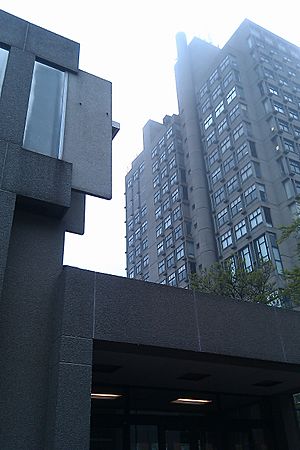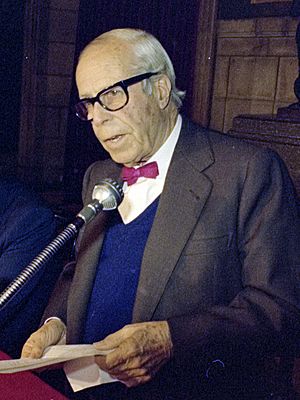Josep Lluís Sert facts for kids

Josep Lluís Sert i López (born July 1, 1902, died March 15, 1983) was a famous architect and city planner from Catalonia, a region in Spain. He is known for his modern designs and for shaping how cities are planned. Sert worked with many important artists like Pablo Picasso and Joan Miró. He also taught at Harvard University in the United States.
Contents
Josep Sert's Early Life and Work
Josep Lluís Sert was born in Barcelona, Catalonia. He was very interested in art and design from a young age. His uncle, Josep Maria Sert, was a painter, and Sert also admired the work of the famous architect Antoni Gaudí.
Sert studied architecture in Barcelona. In 1929, he opened his own design studio. That same year, he moved to Paris to work with the well-known architect Le Corbusier. Sert returned to Barcelona in 1930 and continued his work there.
Modern Architecture Groups
During the 1930s, Sert helped start a group called GATCPAC. This name stands for "Group of Catalan Artists and Technicians for the Progress of Contemporary Architecture." This group later became part of a bigger Spanish group called GATEPAC.
GATEPAC was the Spanish branch of an international organization called CIAM (Congrès International d'Architecture Moderne). CIAM was a very important group for modern architecture. Sert later became the president of CIAM from 1947 to 1956.
Key Projects in Spain
During this time, Sert designed several important modern buildings. These included a weekend house in El Garraf, Catalonia (1935), and the Central Dispensary of Barcelona (1935). He also worked on a big plan for the city of Barcelona between 1933 and 1935.
From 1937 to 1939, Sert lived in Paris again. There, he designed the Spanish Republic's pavilion for the 1937 World's Fair. For this building, Sert asked his artist friends Pablo Picasso, Joan Miró, and Alexander Calder to create art. Picasso's famous painting Guernica was a major part of Sert's design for the pavilion.
Career in the United States
In 1939, Josep Sert moved to New York City. He could no longer work as an architect in Spain at that time. In New York, he joined a group called Town Planning Associates. With them, he created many city plans for places in South America.
Teaching at Harvard
In 1952, Sert was a visiting professor at Yale University for a year. The next year, he became the Dean of the Harvard Graduate School of Design (1953–1969). This was a very important job.
At Harvard, Sert started the world's first degree program in urban design. He also brought together the studies of architecture, city planning, landscape design, and urban design. He taught many architects who are famous today.
Designing Buildings in the US
In 1955, Sert opened his own design studio in Cambridge, Massachusetts. This studio later became a partnership called Sert, Jackson and Associates. They designed many famous buildings, including:
- The Maeght Foundation (1959–1964) in southern France.
- The Fundació Joan Miró museum in Barcelona (1975).
- Several buildings for Harvard University, such as Holyoke Center (1958–1965) and the Harvard Science Center (1969–1972).
- A group of buildings at Boston University, including its law school and main library (1960–1965).
- The Eastwood and Westview apartments on Roosevelt Island, NYC (1976).
In 1961, Sert invited Le Corbusier to the United States to design the Carpenter Center for the Visual Arts at Harvard. A gallery in that center is now named in Sert's honor. In 1981, Sert received the AIA Gold Medal, a very high award for architects.
Sert's Connection to the Art World
Josep Lluís Sert was close friends with many famous artists. These included Alexander Calder, Joan Miró, Georges Braque, and Marc Chagall. He designed studios and homes for some of them.
Sert believed that art was very important in education. He helped bring art into the Harvard curriculum by asking for the Carpenter Center to be built. His designs for the Fondation Maeght in France and the Fundació Joan Miró in Barcelona were more than just buildings. They were places where modern art could be explored and celebrated.
Many students and colleagues who worked with Sert later became leading architects themselves. They came from countries like the United States, Spain, France, Japan, and India.
Major Buildings and Projects
- 1930–1931: Apartment Building at 342 Muntaner Street, Barcelona, Catalonia, Spain
- 1933–1934: Joieria J. Roca (now Rolex Boutique), Barcelona, Catalonia, Spain
- 1933–1935: Dispensari Antituberculós, Barcelona, Catalonia, Spain
- 1932–1936: Casa Bloc, apartment building, Barcelona, Catalonia, Spain
- 1937: Pavilion of the Spanish Republic, Paris (rebuilt in Barcelona in 1992)
- 1955: Joan Miró studio (Fundació Pilar i Joan Miró), Palma, Majorca, Spain
- 1955–1961: Embassy of the United States, Baghdad, Iraq
- 1957: Sert's home at 64 Francis Avenue, Cambridge, Massachusetts
- 1958–1960: Center for the Study of World Religions, Harvard Divinity School, Cambridge, Massachusetts
- 1958–1965: Holyoke Center (now Smith Campus Center), Harvard University, Cambridge, Massachusetts
- 1959–1964: Fondation Maeght in Saint-Paul de Vence, France
- 1964: The Can Pep Simó Estate in Jesús, Ibiza
- 1969: Eastwood and Westview apartment complexes, Roosevelt Island, New York
- 1973: Harvard Science Center, Harvard University, Cambridge, Massachusetts
- 1975: Fundació Joan Miró, Barcelona, Catalonia, Spain
Images for kids
See also
 In Spanish: Josep Lluís Sert para niños
In Spanish: Josep Lluís Sert para niños






